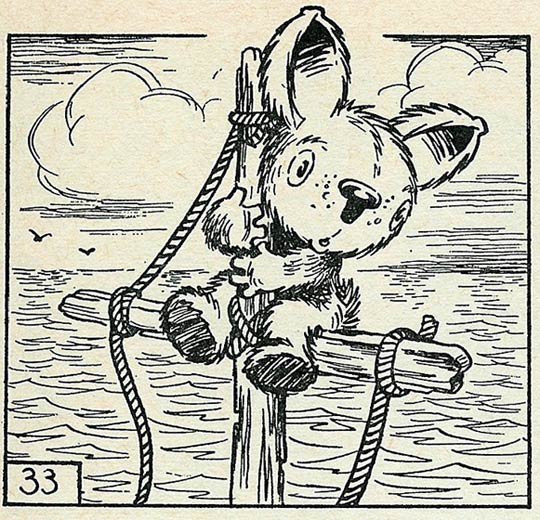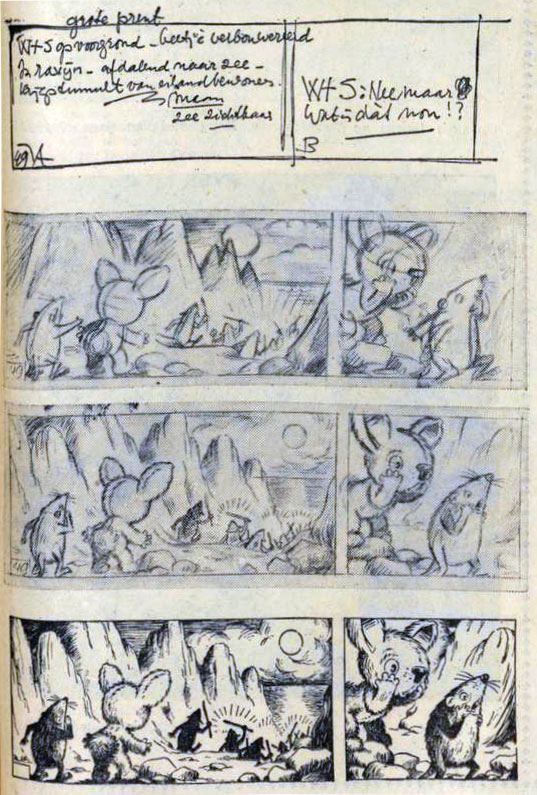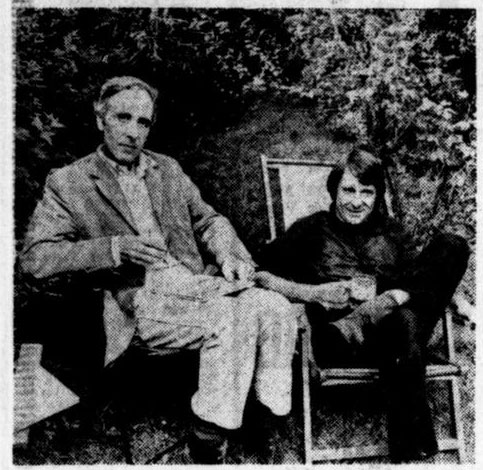'Iwan en De Drie Hoekertjes' (Eva magazine, 1950s).
Jan van Reek was a Dutch comic artist, known for co-creating the popular newspaper comic about dune rabbit 'Wipperoen' (1961-1974) with Raymond Bär von Hemmersweil. Subtly interlaced with social commentary, the funny animal strip appeared in national newspapers like Algemeen Handelsblad and De Telegraaf, as well as several regional and foreign newspapers.
Early life and career
Jan van Reek was born in 1924 in the Dutch naval city Den Helder. He later moved south, settling near Voorschoten, where he struck a lifelong friendship with Raymond Bär von Hemmersweil. The two youngsters shared many hobbies, including photography, chemistry experiments, writing and drawing. During the periods they didn't see each other that often, they corresponded, often adding little comic strips with funny texts to their letters. While Bär went to Art Academy and then worked in advertising, Van Reek joined the military, and served in the Dutch Indies. When he returned to the Netherlands, he became a writer and illustrator for the women's weekly Eva, published by the Nederlandse Rotogravure Maatschappij in Leiden. Working for this magazine between 1955 and 1958, he created text comics like 'Oom Klaas' (1955) and 'Iwan' (1955-1958), while making fairy tale-themed illustrations and short stories for the magazine's children's page.
'Wipperoen'.
Wipperoen
In 1961, Van Reek teamed up with fellow cartoonist Raymond Bär von Hemmersweil - R. Bär in short - to create the newspaper comic 'Wipperoen'. The feature debuted as a text comic on 1 July 1961 in the national newspaper Algemeen Handelsblad. Since they were both cartoonists, Van Reek and Bär had an equal share in the production. After thinking up the story, they both did the pencil sketches and layouts, after which Bär did the finished art and inking and Van Reek wrote the text captions. The adventures of the anthropomorphic rabbit Wipperoen and his funny animal friends were set in a typically Dutch dune landscape, called de Rustige Duinen ("Quiet Dunes"). There, the characters were confronted with strange creatures and objects. While the early stories were straightforward adventure tales with a slightly moralistic undertone, the authors gradually added more social commentary to the 'Wipperoen' stories, tackling subjects like immigration and environmental issues. For instance, in the episode 'De Winterwortelvoorraad', the dune animals collect carrots to send to territories with famine. In other episodes, strangers who enter the Rustige Duinen are treated with mistrust and hostility.
Production of a 'Wipperoen' strip in four stages (Algemeen Handelsblad, 27 April 1962).
Van Reek and Raymond Bär collaborated on 45 'Wipperoen' stories, until Parkinson's disease forced Van Reek to quit in 1972. By 1967, the comic was picked up by the Swan Features Syndicate, after which its publication network quickly expanded. Besides Algemeen Handelsblad, 'Wipperoen' appeared in about 26 regional newspapers in the Netherlands, and also in Televizier magazine. Abroad, the adventures of the dune rabbit were serialized in Belgium (Het Laatste Nieuws, 't Kapoentje), France (La République du Centre), Spain (Tele Express, Ya), Portugal, the UK and South Africa (Cape Town Argus). In France and Spain, the character was called 'Pompon', and in English his name was 'Whipper'. Dutch book collections of 'Wipperoen' stories were published by Van Goor & Zonen and Wolters Noordhoff.
Later 'Wipperoen' years
In 1970, the Algemeen Handelsblad merged with the Nieuwe Rotterdamse Courant into NRC Handelsblad. Since the Nieuwe Rotterdamse Courant ran Marten Toonder's 'Tom Poes' - another funny animal comic with social satire - the editors of the newly formed newspaper had to decide which feature to keep. Nonetheless, 'Wipperoen' continued in NRC Handelsblad with new adventures until September 1972. Around the same time, the Toonder Studio's were working on a series of animated cartoons with Bär and Van Reek's character. Unfortunately, the material for this production was destroyed in a 1971 fire in the Nederhorst den Berg castle, where the Studio's were located. The project was then aborted.
Through mediation from the Toonder Studio's, the 'Wipperoen' feature was transferred to the newspaper De Telegraaf. Coincidentally, this was around the same time that Jan van Reek was forced to quit because of his declining health. Continuing solo, Raymond Bär provided seven 'Wipperoen' stories to De Telegraaf, for the occasion switching from the traditional text strip format into the balloon comic format. Some of these stories were reworked versions of earlier text comics. The final 'Wipperoen' episode concluded in De Telegraaf on 9 November 1974.
Graphic contributions
Not much is known about Jan van Reek's further illustration work. In 1963, Van Reek and Bär used their same funny animal style to make the illustrations for 'Pim, Sam en Floep Maken Een Reis Door De Woestijn' (Van Goor, 1963), a children's booklet for the primary education, written by Sjouke van der Zee.
Death, recognition and legacy
Jan van Reek passed away in 1994. In 2006, he was posthumously awarded the Bulletje & Boonestaakschaal for his contributions to Dutch comics culture, simultaneously with three other veterans of Dutch comics, Raymond Bär, Jan van Haasteren and Willy Lohmann. In that same year, Raymond Bär donated his 'Wipperoen' archives to the Special Collections department of the University of Amsterdam, maintained by Jos van Waterschoot - coincidentally a big 'Wipperoen' fan. Jan van Reek's daughter is illustrator and children's book author Harriët van Reek.
Jan van Reek (left) and Raymond Bär (right). De Telegraaf, 2 September 1972.







